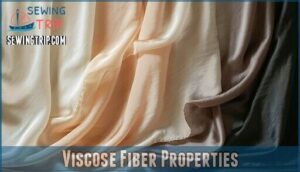This site is supported by our readers. We may earn a commission, at no cost to you, if you purchase through links.

Viscose is delicate and prone to shrinking or wrinkling, so hand washing with cold water and mild detergent is the safest choice.
Gently swish it around, then rinse thoroughly—don’t wring, as it can distort the fibers.
If machine washing is allowed, use a garment bag, choose a cold, delicate cycle, and skip the spin cycle.
Always let viscose air dry flat to maintain its shape.
With these steps, your viscose clothes will stay soft and look their best.
Curious about drying or ironing tips?
Stay tuned!
Table Of Contents
- Key Takeaways
- What is Viscose Fabric?
- Why Choose Viscose Fabric?
- How to Wash Viscose Fabric
- Tips for Washing Viscose Fabric
- How Often to Wash Viscose Fabric?
- Viscose Fabric Care and Repairs
- Storing Viscose Fabric
- APR2030 Sustainability Strategy
- Viscose Fiber Properties
- How to Maintain The Quality of Viscose Fiber?
- Frequently Asked Questions (FAQs)
- Conclusion
Key Takeaways
- Stick to cold water and mild detergent when washing viscose; hand washing is safest, but a gentle cycle in a garment bag works too.
- Never wring or tumble dry viscose; press out water gently and air dry flat to avoid shrinking and damage.
- Iron viscose on a low heat setting with a pressing cloth, and avoid steam to prevent watermarks or weakening the fibers.
- Always check the care label before deciding between hand washing and machine washing to ensure the best outcomes for fragile garments.
What is Viscose Fabric?
Viscose fabric, also called rayon, starts with natural wood pulp transformed through a chemical process into soft, breathable fibers.
Known for its silky feel, it’s great for drapey, lightweight viscose clothing. Blended with fabrics like cotton or spandex, viscose types suit everything from dresses to upholstery.
It’s eco-friendlier than synthetic fabrics but needs gentle care. Avoid harsh washing—handwashing preserves its vibrant colors and delicate structure.
Though elegant, its environmental impact depends on sustainable production practices, like those using responsibly sourced wood pulp. It’s also known for high color retention, making it ideal for vibrant garments.
Why Choose Viscose Fabric?
If you’re after a fabric with fantastic drape and flow, great dye versatility, and unmatched comfort factors, viscose fabric is a solid choice.
This eco-friendly textile, made from renewable wood pulp, offers soft, breathable textures perfect for warm weather.
It’s cost-effective too, giving you affordable style without sacrificing quality.
Plus, viscose clothing retains vibrant colors beautifully with proper viscose care—like cold hand-washing and air drying.
Enjoy the luxury of rayon’s look and feel, all while being kind to the planet with eco-friendly textile choices!
How to Wash Viscose Fabric
Washing viscose fabric requires a gentle approach to prevent damage and maintain its shape. Whether you’re hand-washing or using a machine, always use cold water and a mild detergent.
Hand-Washing
Cold water is your secret weapon when hand washing delicate fabrics like viscose. Add a mild detergent, perfect for preserving its soft texture.
Gently agitate—no harsh scrubbing! Let it soak for just 10-15 minutes to avoid weakening the fibers.
Rinse thoroughly, ensuring no soap residue stays behind. Many prefer a viscose mild detergent for best results.
Press out excess water without twisting or wringing, then lay flat on a towel to air dry. These simple steps protect your viscose clothes, ensuring they stay vibrant and long-lasting with proper care.
Machine-Washing
Ready to skip hand-washing? Machine-washing your viscose pieces is totally doable—just follow these tips to keep your delicate fabrics looking fresh.
Start by selecting the gentle cycle on your machine. Cold water and a mild detergent are must-haves to protect texture and color. Don’t forget to place your garment in a mesh bag to avoid friction damage from the drum or other clothes.
Consider using a specialized laundry product for best results.
Here’s a quick rundown:
- Cycle Selection: Use the gentle cycle with cold water.
- Detergent Choice: Choose a mild detergent to be gentle on fibers.
- Mesh Bags: Always use them to protect from snags or stretching.
- Spin Speed: Opt for the lowest spin speed to minimize stress on the fabric.
- Machine Overload: Avoid overloading; extra room reduces friction.
After washing, air dry flat to maintain its shape and beauty!
Tips for Washing Viscose Fabric
Caring for viscose requires gentle methods to keep the fabric in good shape. Learn the best ways to handle washing, drying, and storing to avoid shrinkage or damage.
Stain Treatment
Nobody likes dealing with fabric stains, but knowing how to treat them can save your favorite viscose items from ruin. Start with stain pretreating—dab, don’t rub. This helps avoid weakening the delicate fibers.
Try a vinegar solution or an oxygen bleach stain remover for common marks. Always do a spot test first to check for discoloration.
For ink or oil stains, a small amount of alcohol can work wonders—but don’t overdo it since alcohol exposure could worsen the damage.
Here are five quick tips to tackle stains safely:
- Dab, never scrub, with a mild detergent.
- Use cold water to rinse.
- Test all cleaners in an inconspicuous spot.
- Avoid harsh bleach that degrades fibers.
- Call in professional cleaning for major stains.
Handle your viscose with care, and it’ll reward you. For red wine stains, consider using baking soda paste to lift the color.
Drying
After tackling stains, it’s time to dry viscose with care to keep its shape and texture.
Gently press out excess water with a clean towel—don’t wring it!
Lay the garment flat on a drying rack or towel, reshaping it while damp.
For larger items, like dresses, hang them on padded hangers in a well-ventilated area to air dry.
Avoid tumble drying entirely—high heat leads to shrinking and damage.
If you want to speed drying, place a fan nearby or open a window, but skip direct sunlight.
Heat damage weakens fibers and fades colors.
Stick to natural drying methods, and you’ll preserve the soft, breathable qualities that make viscose so popular.
Safe drying means longer-lasting clothes!
Ironing
After drying, ironing viscose properly keeps it looking sharp.
Set your iron to the silk setting (around 110°C) and always use a pressing cloth to protect the delicate fabric.
Avoid using steam directly, as it can weaken the fibers. For stubborn creases, a clothes steamer is a gentler option to smooth wrinkles without damage.
Place the garment inside out to prevent fading and focus on quick, light strokes rather than holding the iron in place. Remember to review the correct iron temperature for best results.
Check frequently to avoid over-ironing. These ironing techniques help maintain the fabric’s smooth texture while ensuring those annoying wrinkles don’t steal the show.
Storage
Let’s talk smart storage for your viscose pieces.
Proper care starts with choosing between folding and hanging.
Fold knitwear to avoid stretching, but hang delicate items on padded hangers for gentle support.
Skip plastic bins—they trap moisture, inviting mildew.
Instead, go for breathable cotton garment bags to protect fabrics while maintaining airflow.
Pick a cool, dry storage location to keep colors vibrant and textures smooth.
If you’ve got viscose damp from hand washing, gently squeeze out water first.
Remember, airflow is key—don’t stuff your closet!
Treat your wardrobe wisely, and your viscose stays fresh, strong, and fashion-forward.
How Often to Wash Viscose Fabric?
To keep your viscose garments fresh and long-lasting, it’s best to choose your washing frequency based on wear and activity level.
Frequent wear in humid conditions or during high-activity tasks often leads to odor buildup, meaning the fabric may need washing after two to three uses.
Lightweight items like scarves might last longer between washes, while fitted pieces, like dresses, may require more frequent care.
Here’s a quick guide for laundry care:
- Spot-check first: Look for stains before a full wash.
- Hand-wash when possible: It’s gentler on delicate fibers.
- Machine-wash with care: Use a mesh bag and cold water on a gentle cycle.
- Refresh between washes: Air out lightly worn garments.
Adjusting care based on garment type helps maintain quality.
To prevent damage, remember to avoid harsh chemical treatments.
Viscose Fabric Care and Repairs
Caring for your viscose garments means handling this delicate fabric with care. To prevent viscose shrinkage and maintain softness, always check the label first.
Hand washing clothes in cold water with mild detergent is ideal, though a gentle machine wash with a mesh bag works too. For repairing tears, skip DIY fixes—consult a professional cleaner. Avoid harsh stain treatments; test solutions first.
Lay flat to air dry and reshape damp garments gently. Iron inside out on low heat for fabric care. One should also avoid harsh chemicals like bleach when cleaning viscose.
| Care Task | Best Method | Avoid | Why | Pro Tip |
|---|---|---|---|---|
| Washing | Hand wash, cool water | Hot water, harsh cycles | Hot water shrinks viscose fibers | Use a mesh bag for machines |
| Stains | Dab mild detergent | Scrubbing stains | Weakens fiber structure | Test cleaner for color loss |
| Drying | Flat air-drying | Direct sunlight, heat | Shrinkage, loss of softness | Reshape while damp |
| Repairs | Professional mending | DIY sewing | Fabric frays easily | Call a repair specialist |
| Ironing | Low heat, pressing cloth | High heat, direct contact | Barriers protect the delicate surface | Iron while slightly damp |
Storing Viscose Fabric
In the case of storing viscose, a little preparation goes a long way in keeping it looking great.
This delicate fabric thrives in breathable conditions, so avoid plastic bins that trap moisture and cause mildew. Instead, opt for cotton garment bags.
Here’s a handy guide:
- Folding vs. Hanging: Fold knitwear neatly to prevent stretching. For delicate garments, use padded hangers to keep their shape.
- Long-Term Storage: Place items in a cotton bag or on a drawer shelf to allow airflow, reducing mold risk.
- Mildew Prevention: Keep storage areas dry and cool. Use silica gel packs if needed.
Taking simple steps like these makes certain your viscose favorites stay soft, smooth, and vibrant for years!
APR2030 Sustainability Strategy
The APR2030 Sustainability Strategy focuses on making viscose production cleaner and more eco-friendly. It emphasizes reducing waste, supporting communities, and addressing climate challenges through innovative approaches.
Clean Manufacturing
APR’s sustainability strategy embraces clean manufacturing to support a healthier planet and encourages better fabric cleaning habits.
They’re transforming production by prioritizing energy-efficient processes and ethical production practices.
- Sustainable sourcing: APR uses bio-based fabrics made from renewable wood pulp from certified, responsibly managed forests.
- Closed-loop systems: Materials are reused effectively to minimize waste.
- Waste reduction: Advanced technologies cut energy and water usage, substantially lowering emissions.
- Chemical alternatives: Using safer chemicals guarantees both sustainable production and safer fabric cleaning options.
By addressing concerns like waste and emissions during production, APR guarantees washing clothes becomes part of a more eco-conscious lifestyle for all fabric lovers.
Circular Manufacturing
In the context of sustainable fashion, circular manufacturing guarantees that your viscose garments do good as well as look good.
Using sustainable sourcing, renewable wood pulp, and lifecycle assessment, this approach prioritizes waste reduction by reusing materials through closed-loop systems.
These methods cut energy use with cool water and low temperatures, crafting bio-based fibers that last longer.
With viscose recycling, every thread becomes part of a sustainable journey.
By washing delicate fabrics gently with mild soap and avoiding harsh processes, you protect both the planet and your cherished pieces.
Empowering People
Ethical viscose isn’t just about fabric—it’s about people. APR’s 2030 Sustainability Strategy guarantees fair labor and worker safety while supporting communities with sustainable sourcing.
When you choose viscose made through these initiatives, you’re not just washing delicate fibers, you’re backing a movement that values people and planet.
Wondering how your care routine fits in? Follow these washing instructions:
- Always use a cold water wash to protect delicate fibers.
- Hand washing or machine washing clothes in a mesh bag on a gentle cycle keeps them looking great.
- Avoid wringing; instead, air dry flat to preserve the fabric.
- Low-temp ironing inside-out prevents damage.
- Check care labels to support long-lasting quality.
Your small choices make a big community impact, showing style can truly be sustainable.
Transforming Communities
Through ethical production and environmental stewardship, sustainable viscose fosters community impact.
The APR2030 Strategy transforms lives by promoting fair labor, clean manufacturing, and circular resource use, guaranteeing fashion supports people and the planet.
Here’s a quick snapshot:
| Initiative | Impact | Why It Matters |
|---|---|---|
| Circularity Approach | Reduces waste and reuses materials | Minimizes landfills and resource strain |
| Renewable Resources | Uses wood pulp and cellulose from responsible sources | Encourages replenishable practices |
| Emissions Reduction | Lowers air and water pollution in production | Protects ecosystems and communities |
Whether you’re washing delicate fibers by hand or machine washing clothes, these efforts guarantee every sustainable viscose purchase supports safer, thriving communities.
Follow washing instructions—like cold water wash—and help preserve both your fabrics and the world.
Addressing Climate Change
Sustainable viscose isn’t just comfy—it’s a step toward reducing emissions.
With ethical production and a circular economy approach, it’s made from renewable resources like wood pulp.
Eco-friendly dyes and careful handling help maintain fabric softness.
Using mild detergent, cold water, and gentle handling saves water and energy.
These choices create a soft texture that’s climate-smart and stylish, proving that sustainability looks good on you!
Viscose Fiber Properties
Viscose is a soft, lightweight fabric made from natural fibers like wood pulp, offering excellent breathability and moisture absorbency.
These unique properties make it comfortable to wear and suitable for warm climates, though it requires special care to maintain its quality.
Moisture Absorbent
Viscose is prized for its exceptional absorbency, making it ideal for hot, humid climates where staying cool is key. This fabric’s moisture-wicking properties guarantee comfort while keeping you stylish.
However, viscose’s absorbent nature causes fiber swelling when wet, demanding extra care during cleaning.
- Wash gently: Handwash with cold water and mild detergent to preserve the fabric.
- Turn inside out: Protect colors and texture by washing garments inside out.
- Dry smartly: Lay flat to air dry or hang in a ventilated space, avoiding pins that might leave marks.
- Smooth wrinkles: Use a steamer or low-heat iron for a polished finish.
Proper maintenance lets you enjoy viscose’s benefits while extending its life.
Breathable
How does viscose keep you cool in hot weather? Its breathable nature guarantees fantastic airflow, making it perfect for comfortable clothing, summer fashion, or even athletic wear.
This lightweight fabric keeps your skin happy while maintaining its shape. To preserve its breathability and softness, follow these clothing care tips: hand-wash in cold water or use a wash bag on a gentle machine cycle.
Here’s a quick look:
| Feature | Benefit |
|---|---|
| Lightweight | Reduces heat buildup |
| Breathable | Enhances airflow |
| Skin-Friendly | Prevents irritation |
| Versatile | Fits summer/athletic wear |
| Easy Care | Simple washing and reshaping |
Comfortable to Wear
Everyone loves feeling good in their clothing, and viscose delivers with its smooth, silky touch that adapts wonderfully to your skin sensitivity.
It’s like a breathable hug, keeping you cool in summer and cozy in layering options during colder days.
Perfect for any activity level, it offers flexibility and fabric softness that doesn’t cling or restrict.
To keep that comfort, focus on clothing care.
Hand wash delicate viscose using cold water and mild detergent, or use a wash bag for extra protection during gentle cycle machine washing.
Laundry tips? Avoid harsh wringing—just press gently to remove water.
The best way to wash guarantees viscose stays soft.
For wrinkles, steam lightly and enjoy effortless climate comfort year-round.
Sustainable
Think about how your wardrobe choices can support the planet.
Eco-friendly viscose, made from cellulose in wood pulp or bamboo, brings sustainability to your closet.
It’s biodegradable and crafted using ethical production practices, including recycled viscose and plant-based dyes.
APR’s biobased textile strategy guarantees sustainable sourcing while addressing climate concerns.
Care for this fabric, and it lasts beautifully:
- Use cold water for washing, whether hand or machine.
- Air dry to preserve its softness, steering clear of dryers.
- Iron on low with a pressing cloth to avoid damage.
Viscose gives you style and keeps the earth smiling.
How to Maintain The Quality of Viscose Fiber?
To keep your viscose garments looking great, you’ll need to protect the fibers from damage.
They may feel soft and luxurious, but they’re also delicate and prone to wear.
Start with smart cleaning techniques to avoid fiber degradation.
- Wash Gently: Use cold water, a gentle detergent, and stick to hand washing or machine washing on a delicate cycle.
- Dry Carefully: Air drying is safest—lay garments flat to keep their shape.
- Store Smart: Opt for breathable garment bags, fold knits, and avoid overcrowding in closets to prevent creases.
Avoid long soaks to reduce washing impact.
Skip tumble drying, as heat can weaken the fabric.
These steps bring balance between practicality and protecting your clothing cleaning efforts.
Frequently Asked Questions (FAQs)
Can you hand wash 100% viscose?
Sure thing, washing 100% viscose by hand is totally safe.
Use cold water, a mild detergent, and gently swirl it—no scrubbing.
Rinse thoroughly, press out water carefully, and air dry flat.
What happens if you wash viscose in the washing machine?
Washing viscose in the machine can cause shrinkage, loss of shape, or damage, especially with hot water or high agitation.
Use a gentle cycle, cold water, and a mesh bag to minimize risks.
Does 100% viscose shrink when washed?
Yes, 100% viscose can shrink when washed, especially in warm or hot water.
It’s delicate, so stick to cold water and gentle handling.
Always reshape and air dry to prevent misshaping or further shrinkage.
What happens if I hand wash dry-clean only?
It’s ironic—hand washing "dry-clean only" can backfire.
The fabric might weaken, shrink, stretch, or lose shape.
Chemicals used in dry cleaning stabilize sensitive materials, while water risks damage.
Always follow the care label’s instructions to avoid any potential harm, and remember that water can be particularly risky for sensitive materials.
What is the difference between viscose fabric and viscose fiber?
Viscose fabric refers to the woven or knitted end product, like clothing or upholstery, made from viscose fibers.
Viscose fiber is the raw , processed strand created chemically from cellulose, used to create the fabric.
What is the best way to remove stains from viscose fabric?
Blot stains gently, use a mild detergent or vinegar solution, and test it on a small area first.
Avoid scrubbing to keep fibers intact.
Always wash viscose in cold water and air dry flat.
Does viscose fabric require special detergents?
When washing viscose, use a mild detergent designed for delicate fabrics.
Harsh chemicals can weaken its fibers.
Check the label, avoid bleach, and stick to gentle options to keep the fabric soft and damage-free.
Is it safe to iron viscose fabric?
You can iron viscose safely on a low to medium heat setting.
Always use a pressing cloth and turn the garment inside out.
Avoid steam, as it can leave watermarks or weaken the fabric.
Are there any environmental benefits of using viscose fabric?
Over 90% of viscose comes from renewable materials like wood pulp, making it eco-friendly compared to synthetics.
It’s biodegradable, reducing landfill waste, but guarantee sustainable sourcing to avoid deforestation or harmful production practices.
Can viscose be ironed without damaging it?
You can safely iron viscose by using the lowest heat setting (silk mode) and placing a pressing cloth over it.
Avoid steam, move gently, and never iron viscose when it’s damp to prevent damage.
Conclusion
Did you know viscose fabric can shrink up to 3% if washed improperly?
To keep your garments in top condition, follow proper care techniques.
Hand washing with cold water is safest, but if you prefer a machine, use a delicate cycle with a garment bag.
Avoid spin cycles, always air dry flat, and never wring out the fabric.
By understanding when to hand wash or machine wash viscose, you’ll preserve its softness, shape, and beauty effortlessly.
















